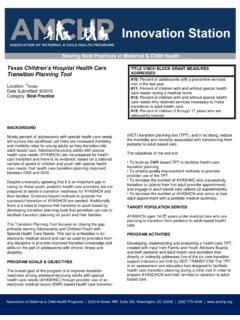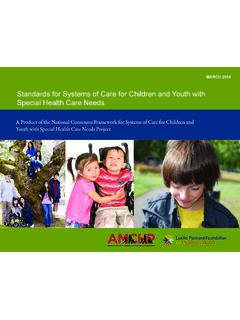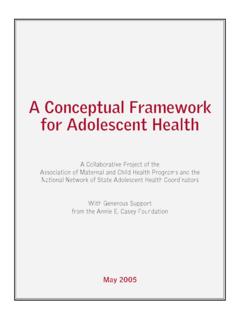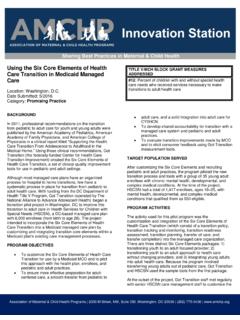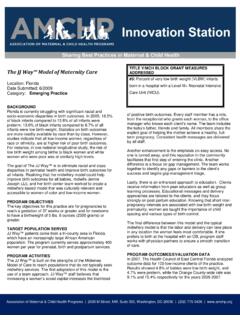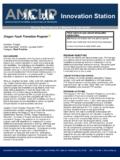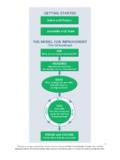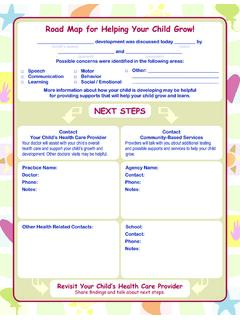Transcription of Survey of Well-being of Young Children (SWYC)
1 Survey of Well-being of Young Children ( swyc ). Ellen C. Perrin, R. Christopher Sheldrick, swyc Overview Comprehensive screening tool (development, behavior, ASD risk, family context). Introduced in 2011. Targeted age range: 1- 65 months Parent report measure May be administered by pediatricians, other clinicians, early educators swyc Overview (cont.). One double-sided form for each typical well -child visit Takes about 10 minutes to complete Questions are multiple choice and written at a 6th grade reading level Easy to administer and score Free of cost, available at Sensitive to cultural differences Amenable to electronic format 3.
2 Preschool Pediatric Symptom Checklist (PPSC). Behavior Development Internalizing Externalizing Baby Pediatric Symptom Checklist (BPSC) Family Context Academic Pediatrics, 2012 FAMILY RISK FACTORS. Academic Pediatrics, 2013. 4. Academic Pediatrics, 2013. Milestones Preschool Pediatric Symptom Checklist Parent's (PPSC) Observations of Behavior Development Social Interactions Internalizing Delays (POSI). Externalizing Autism Infant Mental Health, 2012. Baby Pediatric Symptom Checklist (BPSC) Family Context FAMILY RISK FACTORS. 5. Behavior Development FAMILY RISK FACTORS.
3 Depression PHQ-2. Family Context Tobacco use Alcohol and Other Drug Abuse FAMILY RISK FACTORS. TICS. Family Violence/Discord WAST. Hunger Single item screen 6. Creation of items Wrote and adapted >300 questions based on previously validated screening tests and expert opinion Obtained responses from > 1500 parents of Children 2 months to 5 years old Chose best questions based on statistical analyses of responses Borrowed Family Risk items from previously validated screening questionnaires Example swyc Forms 12-Month 24-Month 8. Example swyc Forms 12-Month Milestones 24-Month Separate form' for each age on pediatric visit schedule 10 items per age 3 Response options Score is sum of items (also IRT scoring).
4 Results can be charted on growth curve . Preliminary validation Predicts developmental delay: sensitivity >70% & specificity >70% for most forms Consistent association with 9. ASQ-3 across forms Example swyc Forms 12-Month 24-Month Social/. Emotional Behavior 10. Example swyc Forms Based on the Pediatric Symptom Checklist (PSC). 1212-Month items, three subscales 24-Month Each scale score is sum of items; score 3 is positive Cronbach's Alpha: ~. across scales Retest reliability: . across scales Overall BPSC compared to ASQ-SE: Sensitivity = 74%, Specificity = 83%.
5 BPSC. <18 months 11. Example swyc Forms Based on the Pediatric Symptom Checklist (PSC). 12-Month 18 items, one overall scale 24-Month Total score is sum of items; score 9 is positive Cronbach's Alpha: ~.87. Retest reliability: .75. Compared to CBCL: Sensitivity = 88%, Specificity = 89%. Compared to diagnosis: Sens = 86%, Spec = 77%. PPSC. 18 months . 5 years 12. Back of swyc Forms 12-Month 24-Month 13. Back of swyc Forms Autism: 12-Month POSI (16-30 months) 24-Month 6 critical items based on MCHAT. 1 additional item about play 5 response options 3 responses in top 3.
6 Categories = positive screen Cronbach's Alpha: . Sensitivity: 83%. (89% in clinical setting). Specificity: 75%. (54% in clinical setting) 14. Example swyc Forms Previously validated 12-Month 24-Month questions selected from the research literature Parental depression Parental substance use (tobacco, alcohol, other drugs). Parental discord Hunger Family Risk Questions 15. Summary: swyc . Accuracy (sensitivity and specificity) comparable to longer screening instruments Comprehensive (cognitive, motor, language and social- emotional development; risk factors).
7 Amenable to electronic format Freely available at Available in English, Spanish, Burmese, Nepali, and Portuguese 16. Current & future work RO1 from NICHD: Large-scale validation with gold standard assessment Study longitudinal use Comparative effectiveness with other screening instruments Translation into other languages Study use and value in settings other than pediatrics Longitudinal screening Electronic administration Population surveillance Publications Sheldrick, & Perrin, (2013) Evidence-based milestones for surveillance of cognitive, language and motor development.
8 Academic Pediatrics. 13(6):577-86. doi: Sheldrick, , Henson, , Neger, , Merchant, S., Murphy, , & Perrin, (2012). The Baby Pediatric Symptom Checklist (BPSC): Development and initial validation of a new social-emotional screening instrument. Academic Pediatrics. 2013 13(1):72-80. doi: Epub 2012 Oct 23. epub ahead of print Oct 20 2012. PMID:23092547. Sheldrick, , Henson, , Merchant, S., Neger, , Murphy, , & Perrin, (2012). The Preschool Pediatric Symptom Checklist (PPSC): Development and initial validation of a new social-emotional screening instrument.
9 Academic Pediatrics, 12(5):456-67. PMID: 22921494. Smith, N, Sheldrick, , Perrin, (2012). An abbreviated screening instrument for Autism Spectrum Disorders. Infant Ment. Health doi: E-pub July 26, 2012. Sheldrick, , Neger, E., Perrin, (2012). Concerns about development, behavior & learning among parents seeking pediatric care. Journal of Developmental and Behavioral Pediatrics, 33(2); 156-160. Sheldrick, , Merchant, S., Perrin, (2011). Identification of developmental-behavioral disorders in primary care: A. systematic review. Pediatrics, 128:356-363, PMID 21727101.
10 Sheldrick, , Perrin, (2009). Surveillance of Children 's behavior and development: Practical solutions for primary care. Journal of Developmental and Behavioral Pediatrics, 30:151-3. PMID 19363367.
